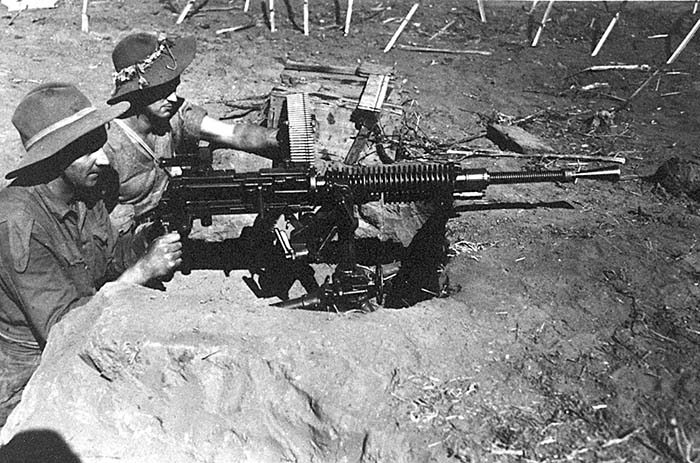Japanese gunners with Type 92 Heavy Machine Gun. Malaya, 1941. Photo: Japanese wartime magazine.
By Edwin Libby
The standard heavy machine gun employed by Imperial Japanese forces in the Pacific War was the Type 92, commonly called the “Juki” by the combatants of both sides. This weapon derived its name from its Japanese designation Jukikanju, or “heavy machine gun” and, although this weapon was regarded a medium machine gun by U.S. forces because of its infantry rifle caliber, the gun’s 122-pound weight with tripod readily demonstrated the logic of its “heavy” classification. The gun was air-cooled and 61 pounds was accounted for by a very heavy barrel housed in a massive receiver casing with large radiator flanges to draw heat away form the mechanism during firing. A slow rate of fire of 350 to 400 rounds per minute, and a hollow-sounding report at a distance, earned the Juki the derisive name of “woodpecker.”

Two Australian Troopers with captured Japanese Type 92 HMG with optical sight. New Guinea, 1944.
The design of the Japanese Type 92 originated with the French Model of 1897 Hotchkiss heavy machine gun, several of which were purchased from the Paris-based Hotchkiss Company, and these guns were used with great success against the Russians in the Russo-Japanese War of 1904-1905. In that war the Japanese Army originated the technique of overhead fire in support of their infantry assaults, but they also used their tripod-mounted Hotchkiss guns to deliver direct fire from front line positions. Although this latter tactic proved to be exceedingly costly in Japanese lives, its success signaled the need for mobile firepower to support infantry on the battlefield. It also stimulated the quest for a light machine gun among the nations who recognized this need from their participation or observation in this first great modern war. After building the French Hotckiss MG under license and after modifying this gun to improve its reliability, the Japanese Army adopted a heavy machine gun of indigenous design, designating it the Taisho Type 3 Model of 1914. This gun was a much developed and refined version of the original French gun with a new and original locking system created by the gun’s designer, Kijiro Nambu, a Japanese Army officer who was to become Japan’s premier firearms designer. Several years later Nambu further refined his Type 3 heavy machine gun with greatly improved iron sights, with added optical sights, and with a new and powerful 7.7mm cartridge for which the refined gun was chambered. In 1932 this gun was adopted by the Japanese Army as the Type 92 heavy machine gun, and this gun was the Japanese heavy machine gun most frequently encountered on the battlefields where U.S. troops were engaged.
Ammunition of various types – ball, tracer, and armor-piercing – on 30-round rigid brass or steel feed strips was used in the Type 92 heavy machine gun. The strips offered a marked contrast to the flexible ammunition belts used by U.S. light, medium, and heavy Browning machine guns and captured Japanese Juki positions littered with empty feed strips and spent cartridge cases remain vivid in the memories of many U.S. combat Marines and soldiers. Each feed strip was packaged in a cloth-covered cardboard sleeve which, with its top removed and the strip engaged in the gun’s feedway, was used to guide the strip and to protect the cartridges on it from dirt and debris. To deliver sustained fire, strips were easily hooked together as they were fed into the gun by the assistant gunner; each cartridge was oiled by a brush in the feedway as it was drawn into the gun.
Ball ammunition of 7.7 diameter (.303 in. caliber) used in the Japanese Type 92 heavy machine gun was loaded typically with a bullet of 204 grains, one of the heaviest rifle caliber ball bullets used in World War II, and very heavy in comparison to the 154-grain ball bullet of the .30 caliber M2 cartridge used in U.S. Browning machine guns. This ammunition gave the Japanese Juki an effective range of 1500 yards, and a remarkable maximum range of 4500 yards. Three different types of optical sights of various powers (4-, 5-, and 6-power) enhanced the accuracy and effectiveness of this weapon. Whenever opportunity was presented the Japanese carefully located and concealed their heavy machine guns and the support positions for these guns, established fire lanes and precise target areas, and registered the fire of these weapons. A Juki in a prepared position and manned by a competent crew was a deadly weapon and a formidable obstacle for any attacking troops.

U.S. Troopers examine a Type 92 HMG captured from the Japanese in 1943.
| This article first appeared in Small Arms Review V4N3 (December 2000) |











